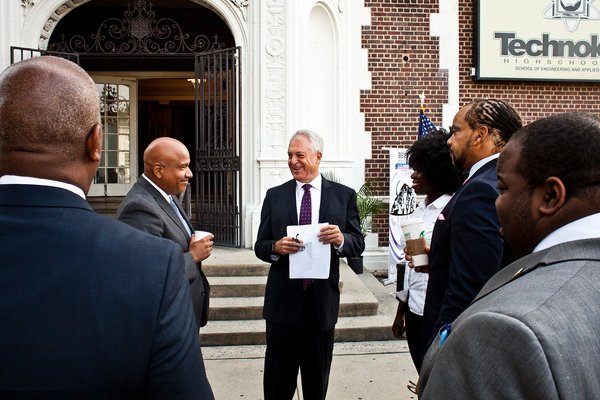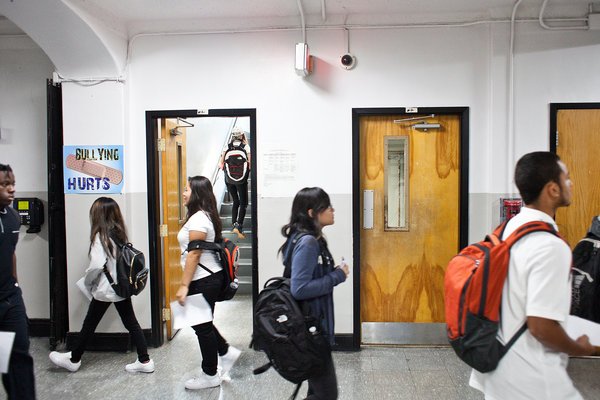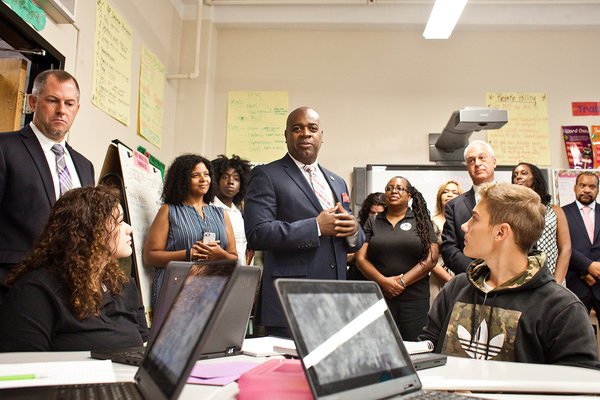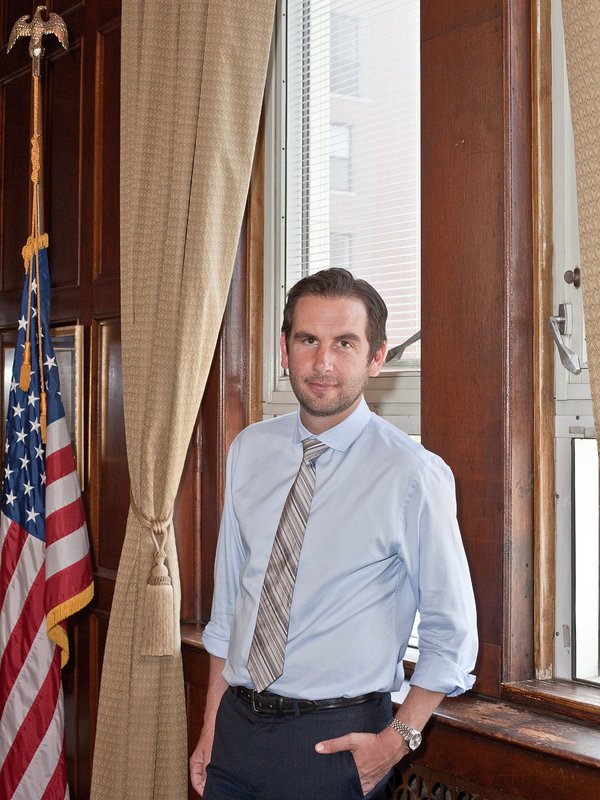
The first day of school at Technology High School in Newark. The graduation rate in the city is now 77 percent, up from 54 percent in 1995, when the state took control of the schools.
NEWARK — In 1995, when Marques-Aquil Lewis was in elementary school, the State of New Jersey seized control of the public schools here after a judge warned that “nepotism, cronyism and the like” had precipitated “abysmal” student performances and “failure on a very large scale.”
For more than 20 years, local administrators have had little leverage over the finances or operations of the state’s largest school district. Choices about curriculum and programs were made mostly by a state-appointed superintendent, often an outsider. The city could not override personnel decisions.
Now, Mr. Lewis’s 4-year-old son is in prekindergarten, and things are changing. With the district improving slowly but steadily in recent years, the state board of education is expected on Wednesday to approve a plan that would ultimately give Newark control again over its public schools with their almost $1 billion budget and 55,000 students.
“Our district has been through a lot of storms, and there were some people who jumped off the boat,” said Mr. Lewis, chairman of the Newark Public Schools Advisory Board, an elected body that has little power under state control. “But there were some people who stayed on, and now everyone wants to come to Newark and be a part of history.”

Christopher D. Cerf, center, was brought in as superintendent of Newark Public Schools in 2015 by Gov. Chris Christie. Mayor Ras Baraka credited Mr. Cerf for being open-minded. “Sometimes you go to a church to infiltrate, and become a deacon,” he said.
The vote comes just two months after the board approved a plan to return control to Jersey City, the state’s second-largest public school system, after almost three decades. And while two other cities — Paterson and Camden — remain under Trenton’s supervision, the 2017-18 school year represents a milestone in the protracted and contentious history of state control.
Newark’s schools have improved — the high school graduation rate is now 77 percent versus 54 percent in 1995; on state tests, the district now ranks in the top quarter of comparable urban districts; low-performing schools were closed while charter schools expanded. The district is retaining more of its best teachers, and fewer of its least effective ones.
But the decision to give authority back to the city is in many ways a recognition that state control is an idea whose time has passed. Around the country, 28 other states enacted similar policies, fueled by a desire to hold districts more accountable. Many of the districts taken over were in heavily minority low-income cities. At present, around 60 districts are under some form of state management, said Kenneth Wong, chairman of the department of education at Brown University.
When New Jersey took over the schools, it was thought of as an emergency intervention. In evaluating the legacy of state control, Paul L. Tractenberg, an emeritus professor of law at Rutgers University, said that the idea went “badly off the tracks” by failing to provide sufficient funding and turning into a “really endless state operation.”
“I’ve devoted my professional life to trying to improve urban education, so I’m the last person to say, ‘What a failure,’” said Mr. Tractenberg, who established the Education Law Center in 1973 to fight for more equitable funding for urban schools. “But I’m also a realist, so I’m not going to say we found a magic bullet and everything is fine now.”

Students at Technology High School in Newark on the first day of school. It has been more than 20 years since the city had authority over its schools.
Main Menu
The New York Times
Search
SUBSCRIBELOG INN.Y. / Region
After More Than 20 Years, Newark to Regain Control of Its Schools
8
The first day of school at Technology High School in Newark. The graduation rate in the city is now 77 percent, up from 54 percent in 1995, when the state took control of the schools.
BRYAN ANSELM FOR THE NEW YORK TIMES
By DAVID W. CHEN
SEPTEMBER 12, 2017
NEWARK — In 1995, when Marques-Aquil Lewis was in elementary school, the State of New Jersey seized control of the public schools here after a judge warned that “nepotism, cronyism and the like” had precipitated “abysmal” student performances and “failure on a very large scale.”
For more than 20 years, local administrators have had little leverage over the finances or operations of the state’s largest school district. Choices about curriculum and programs were made mostly by a state-appointed superintendent, often an outsider. The city could not override personnel decisions.
Now, Mr. Lewis’s 4-year-old son is in prekindergarten, and things are changing. With the district improving slowly but steadily in recent years, the state board of education is expected on Wednesday to approve a plan that would ultimately give Newark control again over its public schools with their almost $1 billion budget and 55,000 students.
“Our district has been through a lot of storms, and there were some people who jumped off the boat,” said Mr. Lewis, chairman of the Newark Public Schools Advisory Board, an elected body that has little power under state control. “But there were some people who stayed on, and now everyone wants to come to Newark and be a part of history.”
Christopher D. Cerf, center, was brought in as superintendent of Newark Public Schools in 2015 by Gov. Chris Christie. Mayor Ras Baraka credited Mr. Cerf for being open-minded. “Sometimes you go to a church to infiltrate, and become a deacon,” he said.
BRYAN ANSELM FOR THE NEW YORK TIMES
The vote comes just two months after the board approved a plan to return control to Jersey City, the state’s second-largest public school system, after almost three decades. And while two other cities — Paterson and Camden — remain under Trenton’s supervision, the 2017-18 school year represents a milestone in the protracted and contentious history of state control.
Newark’s schools have improved — the high school graduation rate is now 77 percent versus 54 percent in 1995; on state tests, the district now ranks in the top quarter of comparable urban districts; low-performing schools were closed while charter schools expanded. The district is retaining more of its best teachers, and fewer of its least effective ones.
But the decision to give authority back to the city is in many ways a recognition that state control is an idea whose time has passed. Around the country, 28 other states enacted similar policies, fueled by a desire to hold districts more accountable. Many of the districts taken over were in heavily minority low-income cities. At present, around 60 districts are under some form of state management, said Kenneth Wong, chairman of the department of education at Brown University.
When New Jersey took over the schools, it was thought of as an emergency intervention. In evaluating the legacy of state control, Paul L. Tractenberg, an emeritus professor of law at Rutgers University, said that the idea went “badly off the tracks” by failing to provide sufficient funding and turning into a “really endless state operation.”
“I’ve devoted my professional life to trying to improve urban education, so I’m the last person to say, ‘What a failure,’” said Mr. Tractenberg, who established the Education Law Center in 1973 to fight for more equitable funding for urban schools. “But I’m also a realist, so I’m not going to say we found a magic bullet and everything is fine now.”
Students at Technology High School in Newark on the first day of school. It has been more than 20 years since the city had authority over its schools.
Indeed, test scores and other metrics barely budged for years. Newark’s first state-appointed superintendent, Beverly Hall, a former New York City education official, clashed with parents and educators, and left the district in 1999 with a staggering deficit amid questions of fiscal mismanagement. Later, as superintendent of the Atlanta schools, she was indicted in a widespread cheating scandal, but died in 2015 awaiting trial.
Just as polarizing, if not more so, was Cami Anderson, a veteran of the New York City schools under former chancellor Joel I. Klein who was appointed by Gov. Chris Christie in 2011. Her plan to reorganize the schools, which included closing low-performing ones and opening many charter schools, and creating an open enrollment system that did away with some neighborhood schools, played a role in the fractious 2014 Newark mayor’s race won by Ras J. Baraka, a former teacher and high school principal. She resigned the next year.
In 2015, Governor Christie tapped Christopher D. Cerf, a hard-charging former state education commissioner and yet another disciple of Mr. Klein’s, as the next superintendent. In an interview at City Hall, Mr. Baraka said that he had expected the latest outsider to be “very rigid” and “carry the governor’s water.”
But the two men instead forged an unexpectedly productive relationship. A new teachers’ union contract, signed in May, featured little of the rancor from years past, and Mr. Baraka has helped to defuse tensions between charter and traditional schools. Charter enrollment has tripled in the past five years and Ms. Anderson’s much maligned open enrollment plan has been modified with more community input.
In the interview Mr. Baraka credited Mr. Cerf for being open-minded. “Sometimes you go to a church to infiltrate, and become a deacon,” he said.

And Mr. Cerf, in news conference on the first day of school, praised Mr. Baraka as “a truly great educator, in my judgment, a truly great man.”
Mr. Baraka and Mr. Cerf worked closely with local institutions like Rutgers-Newark, as part of a broader civic strategy that has attracted more investment. About $10 million of a splashy but controversial $100 million gift from Mark Zuckerberg, the Facebook founder, helped to finance a network of “community schools,” long sought by Mr. Baraka, to provide health care and social services beyond classroom hours.
New Jersey lawmakers in 2007 had established a system to assess school districts, as well as an exit strategy under which districts could regain independence: It required them to meet certain benchmarks, like passing rates on state tests or the percentage of students graduating from high school. That system was criticized by some as unfair and unforgiving. So, in 2016, it was softened to allow districts to show progress on those markers, rather than hitting specific targets.
That same year, a panel appointed by Mr. Christie and Mr. Baraka reported that while on the annual statewide tests just 22 percent of Newark students were proficient in English, and 17 percent passed in math, they were well ahead of students in comparable urban districts, and showed improvement (on the latest tests, 31 percent of students passed the English portion of the test, while 23 percent were proficient in math). The report also outlined a “pathway” to local control to “ensure that the challenges that led to state takeover will not recur.”
Yet chronic absenteeism — defined as students missing more than 18 school days a year — remains “far too high” at 22 percent. And while school suspensions and reports of violence and vandalism have fallen over the last few years, “many students still report feeling unsafe at school,” the report said.

“This isn’t like you flip a switch,” Mr. Cerf said in an interview, noting the gradual pace of progress.
In August, the state’s education commissioner, Kimberley Harrington, concluded that the district, which already had been given partial control over some parts of the system, had made significant enough gains to set the stage for Wednesday’s vote for full local control.
Barring any unexpected snags, the district and the state will now develop a formal transition plan. Sometime next year, a public referendum will determine whether voters want an elected school board, or one appointed by the mayor. The board will then have the power to hire and fire its own superintendent; Mr. Cerf’s contract ends in June.
Jersey City was actually the first district in New Jersey to lose control of its schools in 1989, after Gov. Thomas H. Kean, acting on a 1987 law, declared that its students were being “subjected to educational child abuse.” The city, which has experienced a renaissance in recent years, was also the first to make major strides in wresting control back of its improving schools. Among the key factors, according to Mayor Steven Fulop, were changes in the school board after hard-fought elections, greater involvement by parents who resisted moving to the suburbs and changes in policy. He also praised the approach of the school superintendent, Marcia V. Lyles.
But Mr. Fulop gives little credit to the state. “Those things converging have helped the school system gradually get better; it has nothing to do with the State of New Jersey’s policies,” Mr. Fulop said. “You wouldn’t find anybody who points to state control and says, thankfully the state was here.”
Mr. Baraka, among others, is hopeful that when the transition is complete, the city will have learned its lesson.
“Local control means that you’re in charge now — you can’t cuss out people now unless you’re cussing yourself out,” he said. “Stop thinking about us versus them, because us is the them.”
Hi! I am a robot. I just upvoted you! I found similar content that readers might be interested in:
https://www.nytimes.com/2017/09/12/nyregion/20-years-newark-schools-regain-control-baraka.html